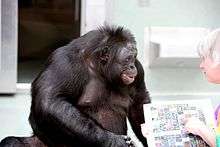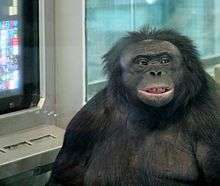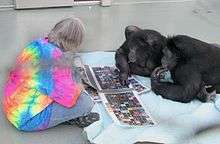Kanzi
| Kanzi | |
|---|---|
.jpg) | |
| Born |
October 28, 1980 Georgia State University |
| Known for | Intelligent use of lexigram |
| Relatives |
Lorel (mother) Panbanisha (sister) Nyota (nephew) Nathen (nephew) Elikya (sister) Maisha (brother) Teco (nephew) |




Kanzi (born October 28, 1980), also known by the lexigram ![]()
Biography
Born to Lorel and Bosandjo at Yerkes field station at Emory University and moved to the Language Research Center at Georgia State University, shortly after birth Kanzi was stolen and adopted by a more dominant female, Matata. Kanzi and his sister (Matata's offspring, now deceased) moved to the Ape Cognition and Conservation Initiative (ACCI),[4] formerly the Great Ape Trust, in Des Moines, Iowa, where Kanzi is the alpha male of the resident community of Bonobos. He turned 37 in October 2017.
As an infant, Kanzi accompanied Matata to sessions where Matata was taught language through keyboard lexigrams, but showed little interest in the lessons. It was a great surprise to researchers then when one day, while Matata was away, Kanzi began competently using the lexigrams, becoming not only the first observed ape to have learned aspects of language naturalistically rather than through direct training, but also the first observed bonobo to appear to use some elements of language at all.[2][3] Within a short time, Kanzi had mastered the ten words that researchers had been struggling to teach his adoptive mother, and he has since learned more than two hundred more. When he hears a spoken word (through headphones, to filter out nonverbal clues), he points to the correct lexigram.[2][3]
According to a Discover article, Kanzi is an accomplished tool user.[5]
Kanzi's adoptive mother, Matata, lived to be one of world's oldest captive bonobos until her death in June 2014.[6] In the matriarchal society of bonobos, a male's position is primarily determined by the position of the females he is related to; Matata was the group's chief leader. According to the Smithsonian magazine, Kanzi "has the mien of an aging patriarch – he's balding and paunchy with serious, deep-set eyes."[7] This description is confirmed by a full-page color photograph of Kanzi in the March 2008 National Geographic, and a full-page black-and-white photograph in Time magazine.[8]
Examples of Kanzi's behavior and abilities
Kanzi's behavior and abilities have been the topic of research published in scientific journals, as well as reports in popular media.
Research programs
When he was eight years old, Kanzi was a subject of a research program in which his ability to respond to spoken requests was compared with that of a two-year-old human child called Alia. The study took nine months to complete. Kanzi and Alia were given 660 spoken instructions, asking them to deal with familiar objects in novel ways. Kanzi responded correctly to 74 percent of the instructions, Alia to 65 percent.[9][10]
Another study aimed to see whether Kanzi could learn to make and use stone knives comparable to Oldowan tools. Kanzi was taught by Dr. Nick Toth, who is an anthropologist with the Stone Age Institute in Bloomington, Indiana. Kanzi created stone knives which are very sharp and can cut animal hide and thick ropes. In the experiment, Kanzi was not only taught how to flake, he also developed his own method by throwing the cobbles onto hard surfaces to make a flake, as opposed to the hand-held percussion method that was taught to him. Kanzi's own method is what produced the majority of the 294 artifacts produced during the experiment.[11][12]
Anecdotes
The following are highly suggestive anecdotes, not experimental demonstrations.
- In an outing in the woods in Georgia, Kanzi touched the symbols for "marshmallows" and "fire". Susan Savage-Rumbaugh said in an interview that, "Given matches and marshmallows, Kanzi snapped twigs for a fire, lit them with the matches and toasted the marshmallows on a stick."[13] The Telegraph has published photos of Kanzi putting together a fire for food.[14]
- Paul Raffaele, at Savage-Rumbaugh's request, performed a haka for the Bonobos. This Māori war dance includes thigh-slapping, chest-thumping, and hollering. Almost all the bonobos present interpreted this as an aggressive display, and reacted with loud screams, tooth-baring, and pounding the walls and the floor. Kanzi, who remained perfectly calm, communicated with Savage-Rumbaugh using bonobo vocalizations; Savage-Rumbaugh understood these vocalizations, and said to Raffaele, "he'd like you to do it again just for him, in a room out back, so the others won't get upset." Later, a private performance in another room was successfully, peacefully, and happily carried out.[13]
- Sue Savage-Rumbaugh has observed Kanzi in communication to his sister. In this experiment, Kanzi was kept in a separate room of the Great Ape Project and shown some yogurt. Kanzi made some vocalizations which his sister could hear; his sister, Panbanisha, who could not see the yogurt, then pointed to the lexigram for yogurt, suggesting those vocalizations may have meaning.[13][15]
- In one demonstration on the television show Champions of the Wild,[16] Kanzi was shown playing the arcade game Pac-Man and understanding how to beat it.
- According to a 2014 report, Kanzi not only enjoys eating omelettes, but also cooks omelettes for himself. He asks for the ingredients using his lexigram.[17]
Language
Although Kanzi learned to communicate using a keyboard with lexigrams, Kanzi also picked up some American Sign Language from watching videos of Koko the gorilla, who communicated using sign language to her keeper Penny Patterson; Savage-Rumbaugh did not realize Kanzi could sign until he signed "You, Gorilla, Question" to anthropologist Dawn Prince-Hughes, who had previously worked closely with gorillas.[18] Based on trials performed at Yerkes Primate Research Center, Kanzi was able to correctly identify symbols 89-95% of the time.[19]
Kanzi cannot speak vocally in a manner that is comprehensible to most humans, as bonobos have different vocal tracts from humans, which makes them incapable of reproducing most of the vocal sounds humans make. At the same time, it was noticed that every time Kanzi communicated with humans with specially designed graphic symbols, he also produced some vocalization. It was later found out that Kanzi was actually producing the articulate equivalent of the symbols he was indicating, although in a very high pitch and with distortions.[20]
See also
- Ape language
- Evolution of language
- Human Ape, a National Geographic documentary film
- Yerkish
Other animals used in language studies:
References
- ↑ Kluger, Jeffrey (August 5, 2010). "Inside the Minds of Animals". Time. Retrieved December 13, 2014.
- 1 2 3 Savage-Rumbaugh, S., & Lewin, R., (1994). Kanzi: The Ape at the Brink of the Human Mind. Wiley. ISBN 0-471-58591-2.
- 1 2 3 Mitani, J. (1995). "Kanzi: The Ape at the Brink of the Human Mind". Scientific American. 272 (6). ISSN 0036-8733.
- ↑ "ACCI: Ape Cognition & Conservation Initiative". apeinitiative.org. Retrieved 2016-03-08.
- ↑ "Ape at the Brink". Discover. September 1994.
- ↑ Finney, Daniel (June 22, 2014). "Bonobo Matata dies at Des Moines ape conservation". The Desmoines Register. Retrieved 27 June 2014.
- ↑ Raffaele, Smithsonian, November 2006.
- ↑ Time, August 16, 2010.
- ↑ Savage-Rumbaugh, E. Sue (1993). "Language Comprehension in Ape and Child". Monographs of the Society for Research in Child Development. 58 (3 to 4). doi:10.2307/1166068. JSTOR 1166068.
- ↑ Harris, Margaret; Butterworth, George (2012). Developmental Psychology: a Student's Handbook. Psychology Press. pp. 178 to 180. ISBN 9781135844677.
- ↑ Schick, K. D., Toth, N., Garufi, G., Savage-Rumbaugh, E. S., Rumbaugh, D., & Sevcik, R. (1999). Continuing Investigations into the Stone Tool-making and Tool-using Capabilities of a Bonobo (Pan paniscus). Journal of Archaeological Science, 26(7), 821-832.
- ↑ Savage-Rumbaugh, Sue; Lewin, Roger (1994). Kanzi: the Ape at the Brink of the Human Mind. John Wiley. pp. 201 to 222. ISBN 978-0471159599.
- 1 2 3 Raffaele, P (November 2006). "Speaking Bonobo". Simithsonian. Retrieved 2008-03-18.
- ↑ "Amazing photos of Kanzi the bonobo lighting a fire and cooking a meal". The Daily Telegraph. December 30, 2011.
- ↑ Savage-Rumbaugh, Sue; Fields, William M.; Spircu, Tiberu (2004). "The emergence of knapping and vocal expression embedded in a Pan/Homo culture" (PDF). Biology and Philosophy. 19: 541–575. doi:10.1007/sbiph-004-0528-0.
- ↑ Season 4, Episode 3. Screened 10/30/2000
- ↑ Leonard, Tom (June 7, 2014). "He can cook, play music, use a computer - and make sarcastic jokes chatting with his 3,000-word vocabulary: My lunch with the world's cleverest chimp (who Skyped me later for another chat)". Daily Mail. Retrieved 27 June 2014.
- ↑ Prince-Hughes, Dawn (1987). Songs of the Gorilla Nation. Harmony. p. 135. ISBN 1-4000-5058-8.
- ↑ Williams, S.L. (1997). "Comprehension Skills of Language-Competent and Nonlanguage-Competent Apes". Language and Communication Journal.
- ↑ Greenspan, S. I., and S. G. Shanjer. 2004. The first idea: How symbols, language and intelligence evolved from our primate ancestors to modern humans. Da Capo Press.
Further reading
- Joseph, John E., Nigel Love & Talbot J. Taylor (2001). Landmarks in Linguistic Thought II: The Western Tradition in the 20th Century (London & New York: Routledge), chapter 15: "Kanzi on Human Language".
- de Waal, Frans (2005). Our Inner Ape, ISBN 1-57322-312-3.
- Raffaele, Paul (2006), "The Smart and Swinging Bonobo", Smithsonian, Volume 37, Number 8 (November 2006—a general article about bonobos).
External links
| Wikimedia Commons has media related to Kanzi (pan paniscus). |
- 60 Minutes Australia Talk to the Animals October 2011 featuring Kanzi
- A review of Kanzi: The Ape at the Brink of the Human Mind by Dr. S. Goldin-Meadow
- Kanzi recognizing the symbols of the lexigram on YouTube
- The Gentle Genius of Bonobos, TED talk in part about Kanzi
- Video documentary site by Sue Savage-Rumbaugh containing a documentary featuring Kanzi
- Speaking Bonobo article at the Smithsonianmag webpage